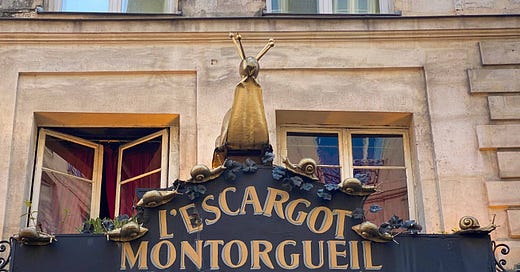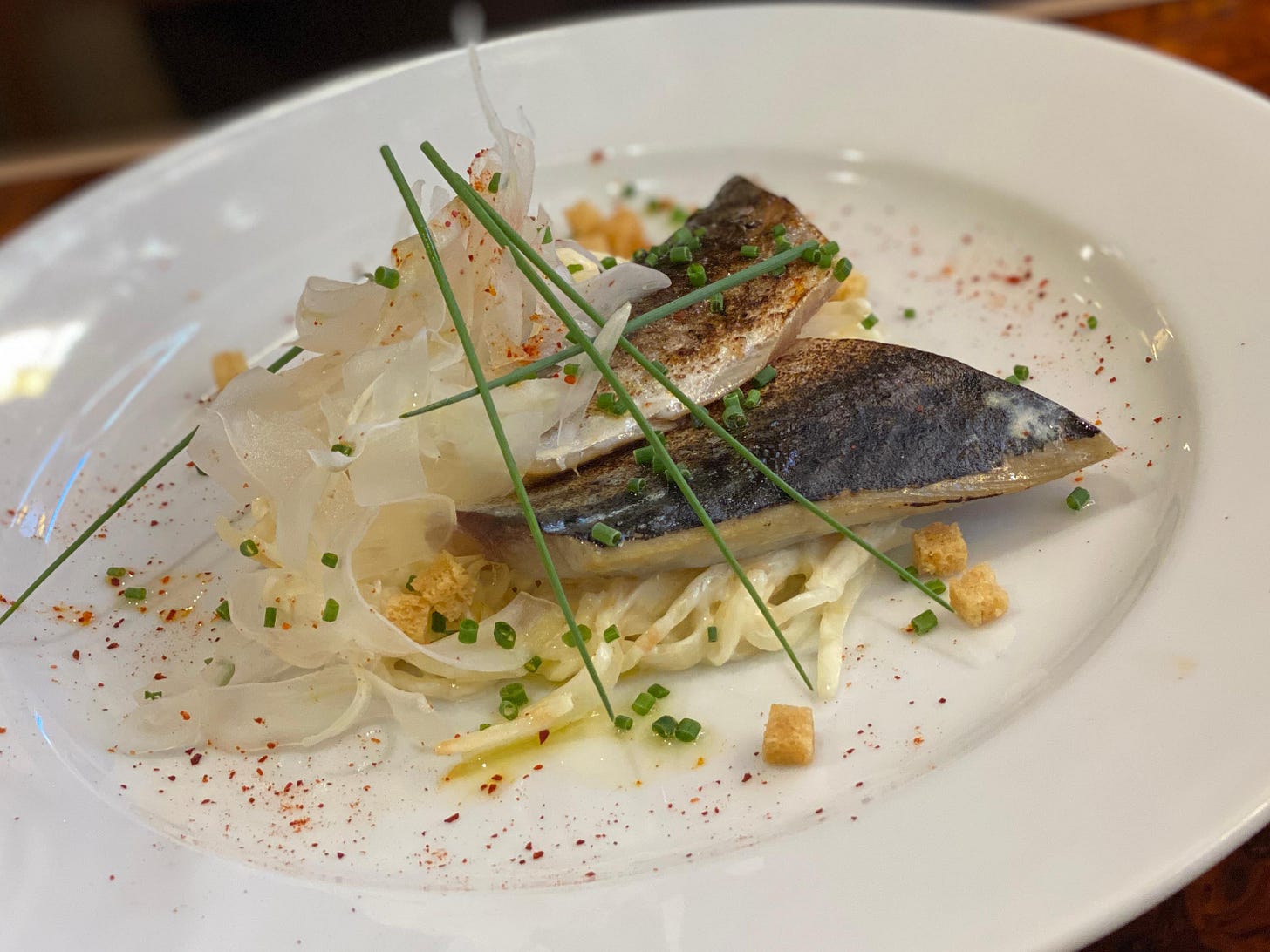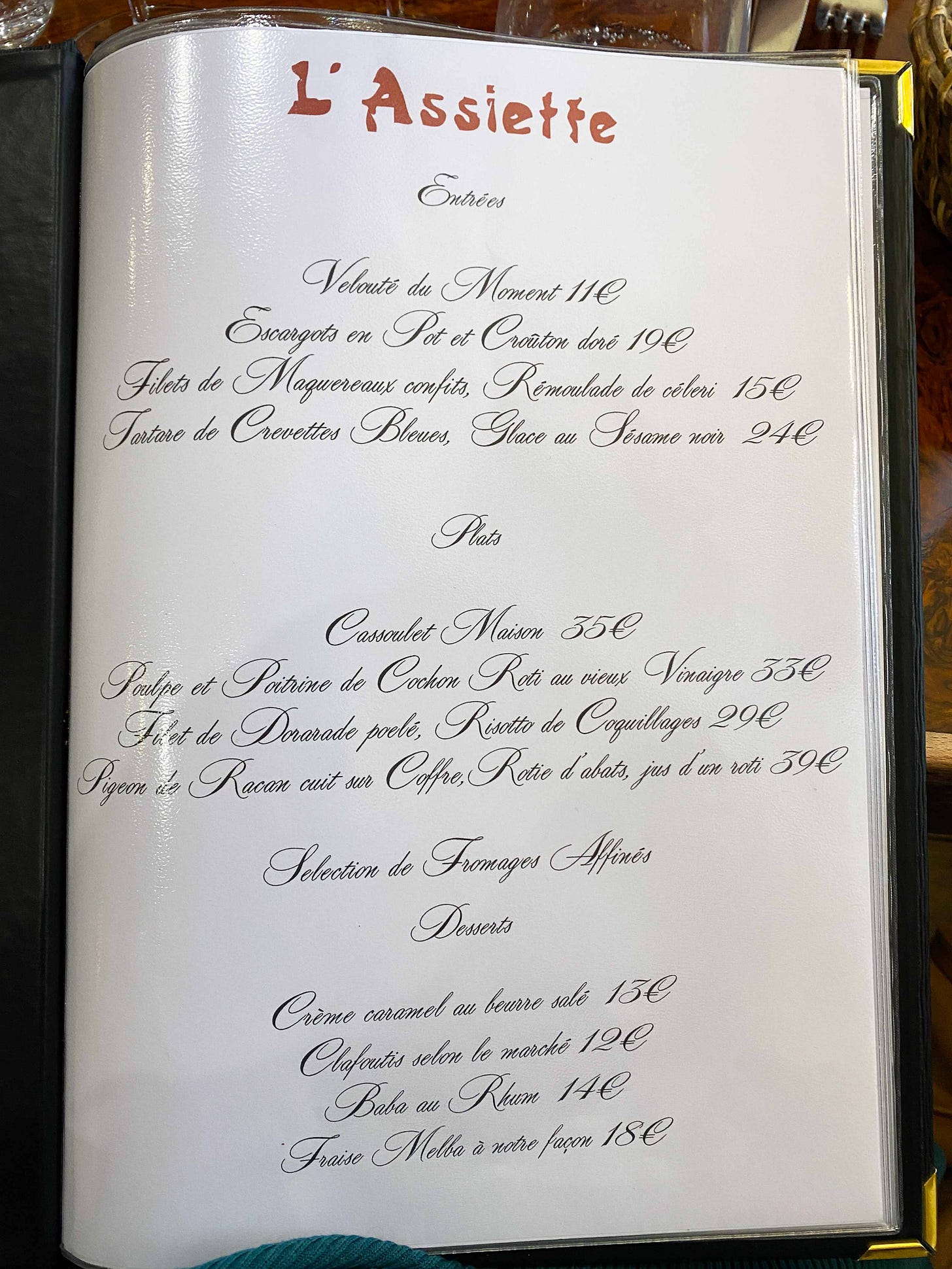France trend report: Escargots, herring and mimosa treatments galore — but 86 the mustard
That's some of what I found on my recent trip to Paris and points southwest.
Just when I’d proclaimed that magret de canard — duck breast — is a national obsession in France, I arrived for a 16-day stay only to find that maybe the French are starting to get ducked-out. Compared with what I’d observed just nine months ago on my last visit, magret seemed much less ubiquitous.
In Paris (which I’d skipped last year), escargots seemed to be everywhere. “Six gros escargots sauvages de Bourgogne” — 6 wild snails from Burgundy — was the order of the day. They beckoned from the menu at Café de Commerce, the historic “bouillon” in the 14th arrondissement, and shouted “choose me!” at popular routier-style spot Aus Bons Crus in the 11th. Six big ones proposed to be ordered at Chez Georges, a beautiful art nouveau brasserie in the 17th that’s nearly 100 years old. “Escargots en Pot et Crouton doré” was one of the enticing entrées at L’Assiette, chef David Rathgeber’s charming place in the 14th. (In France, “entrées” are the starters; the entries into the meal.)
Weirdly, I didn’t order escargots anywhere. What was wrong with me?! And what can I say in my own defense? Only that other tempting savories caught my eye.
More on that presently. First I need to tell you something pressing:
We may well be headed for a global mustard shortage
It might have escaped my notice had I not listened (against my better judgement) to my husband and son when they were trying to hurry me out of an organic grocery in Lacanau-Ville, a small town in the southwest, not far from where my in-laws have a beach house. The boys were ready to leave. But I was finding so many interesting things! We’d be cooking at home, so we needed mustard. My hand was on a jar. The boys lost patience. We’re headed to the hypermarché, next, they said. We’ll buy it there. That one’s not even organic.
I relented. I removed my hand from the jar and backed away. Of course they’d have it at the hypermarché — a giant supermarket.
Or would they?
Off we went — and weirdly, at the hypermarché, I couldn’t find the Dijon shelf. Around and around I went. Usually, it’s next to the mayo, but no. There was another lady looking as confused as I was. After twenty minutes of looking, I located a person — who led me right where we two had been looking. He pointed to an empty shelf. “Il n’ya plus,” he said, shrugging. It’s 86. Quatre-vingt-six.
Nor did they have it at the next supermarket, in Lacanau-Océan, nor at the superette. Empty shelves partout. Back at the beachhouse, I Googled “mustard shortage” and found this:
“Why Canada’s to blame for the global Dijon mustard shortage”
Really, it had already reached France? I checked when we drove down to Arcachon (another seaside town, where my sister-in-law lives) and found a vacant shelf. Two otherwise well-stocked groceries in Paris — a Monoprix and the big market hall at Bon Marché — were completely out.
Would you blame me if, on returning home to the U.S., I bought four jars of Maille Dijon Originale, and four Maille whole-grain? (I do like a mustardy vinaigrette!)
If you don’t feel OK without Dijon, you might want to pick up a jar. Or deux. Or, if you have a restaurant, vingt. Don’t say you heard it from me.
“Mustard Shortage Could Spell 4th of July Disaster for Hot Dog Fans,” Newsweek, June 25, 2022
🐌 🐌 🐌 🐌 🐌 🐌
So, back to those trends.
Make it mimosa
Stateside, mimosa is a brunch beverage. In France, mimosa means chopped hard-boiled eggs over a sauce vinaigrette (need that moutarde!) on some kind of vegetable — like leeks, asparagus or artichokes.
In Paris, I saw mimosa everywhere. At Chez Georges, fat spears of white asparagus mimosa was the reason I said non to les escargots. (And by the way, no one in Paris serves crunchy asparagus; tender, luscious and cooked through is correct.) Aux Bons Crus’ menu offered Artichaut Vinaigrette, which I ordered — and was asked if maybe I’d prefer Artichaut Mimosa. I would! What fun!
Herring and friends
I’ve always loved the bistro classic marinated herring fillets with steamed potatoes, and the entrée seems to be having a moment. I couldn’t resist ordering the simple, straightforward version at Cafe du Commerce. At Chez Georges, the fillets swam with carrots and onions in a luxuriously deep pond-bowl of oil, to be fished out and transferred to a plate.
Somehow the confit mackerel fillets with céleri rémoulade at L’Assiette seemed to be playing off the classic herring-potato set-up — with mackerel standing in for herring, and celery root standing in for potato. This loose interpretation (if that’s what it was) was my favorite iteration by far.
The other thing that was insanely good at L’Assiette: Cassoulet Maison. Perhaps it was the best cassoulet I’ve ever had.
I know what you’re thinking: Cassoulet in the summer? All those creamy rich beans and duck fat and confit and saucisses? Crazy at it seems, celebrating cassoulet in summer is actually a thing. If you don’t believe me, then explain why the famous Cassoulet Festival of Castelnaudary (Castelnaudary is said to be the dish’s birthplace) takes place in August.
Food, as they say, for thought.
The takeaways
Something in my bones tells me French food is about to come back into major vogue in the U.S. — which is why I was so attracted on my trip to the kinds of classic dishes you find in old-school bistros, bouillons and brasseries. I’ll be exploring French dishes and creating recipes at my cooking site, Cooks Without Borders (there already quite a few in the French section).
Oh, something else I wanted to mention: The prices I found at many of these restaurants were much lower than what you’d find in analogous places stateside. At Cafe du Commerce, the herring was 8.90 euros; the six wild Burgundy escargots were 9.80. (At the moment, 1 euro = $1.05, so nearly equal.) Plats (main courses) Ranged from 17.50 (skate wing grenobloise) to 22.80 (filet de bar, aka branzino). Magret à l’orange: 21.60. Steak frites featuring Limousin beef starts at 21.50, for a bavette. [See the menu prices.]
Nearly everyplace we ate offered a “menu” or “formule” for lunch — two or three courses for a set price. On my IG feed, I’ve posted my favorite fixed-price Paris lunch from the trip — at a tiny place in the Belleville neighborhood called Le Pinceau. Two courses (entrée + plat or plat + dessert) are 18 euros; three courses are 21 euros. I’ll post more there in coming days (please feel free to follow me there.)
We found some unpleasant attitude in France (I gave one restaurateur a taste of his own medicine in Bordeaux) and some extraordinarily delightful hospitality (including another place in Bordeaux). In Paris, we experience a series of missteps that were followed, when we paid our tab, by a sincere apology and comping of drinks (though we hadn’t even complained). Well done.
Nota bene: My mentions of the various restaurants in this missive are not meant to constitute wholehearted recommendations. That said, in addition to Le Pinceau, I do highly recommend L’Assiette, David Rathgeber’s place, where we loved the cooking, the hospitality (including outstanding unpretentious wine service), the vibe, the room and the tight, carefully assorted menu. What a wonderful evening! (Thank you to Dallas chef Bruno Davaillon for the recommendation.)
OK, A+ as they text in France — short for à plus tard, or see you soon. My consulting business has me extremely busy these days, but I’ll try not to be such a stranger.
🐞











I guess they didn’t peg you as a typical American tourist, you probably even parked francaise
David’s last name is Rathgeber. As someone born with the same surname, I cannot but defend it.